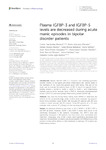Plasma IGFBP-3 and IGFBP-5 levels are decreased during acute manic episodes in bipolar disorder patients

View/
Use this link to cite
http://hdl.handle.net/2183/36722
Except where otherwise noted, this item's license is described as Creative Commons Attribution 4.0 International License (CC-BY 4.0)
Collections
- Investigación (FCS) [1293]
Metadata
Show full item recordTitle
Plasma IGFBP-3 and IGFBP-5 levels are decreased during acute manic episodes in bipolar disorder patientsAuthor(s)
Date
2024-04-24Citation
Fernández-Pereira C, Penedo MA, Alonso-Núñez A, Rivera-Baltanás T, Viéitez I, Prieto-González JM, Vilariño-Vilariño MI, Olivares JM, Ortolano S, Agís-Balboa RC. Plasma IGFBP-3 and IGFBP-5 levels are decreased during acute manic episodes in bipolar disorder patients. Front Pharmacol. 2024 Apr 24;15:1384198.
Abstract
[Abstract] Introduction: Bipolar disorder (BD) is a recurrent and disabling psychiatric disorder related to low-grade peripheral inflammation and altered levels of the members of the insulin-like growth factor (IGF) family. The aim of this study was to evaluate the plasma levels of IGF-2, insulin-like growth factor-binding protein 1 (IGFBP-1), IGFBP-3, IGFBP-5, IGFBP-7, and inflammatory markers such as tumor necrosis factor α (TNF-α), monocyte chemoattractant protein 1 (MCP-1), and macrophage inflammatory protein 1β (MIP-1β). Methods: We used the Young Mania Rating Scale (YMRS) to determine the severity of the symptomatology, while proteins were measured by enzyme-linked immunosorbent assay (ELISA). We included 20 patients with BD who suffered a manic episode and 20 controls. Some BD patients (n = 10) were evaluated after a period (17 ± 8 days) of pharmacological treatment. Results: No statistical difference was found in IGF-2, IGFBP-1, IGFBP-7, TNF-α, and MIP-1β levels. However, IGFBP-3 and IGFBP-5 levels were found to be statistically decreased in BD patients. Conversely, the MCP-1 level was significantly increased in BD patients, but their levels were normalized after treatment. Intriguingly, only IGFBP-1 levels were significantly decreased after treatment. No significant correlation was found between the YMRS and any of the proteins studied either before or after treatment or between IGF proteins and inflammatory markers. Discussion: To some extent, IGFBP-3 and IGFBP-5 might be further explored as potential indicators of treatment responsiveness or diagnosis biomarkers in BD.
Keywords
Young Mania Rating Scale
Bipolar disorder
Inflammation
Insulin-like growth factor 2
Insulin-like growth factor-binding proteins
Macrophage inflammatory protein 1 beta
Monocyte chemoattractant protein 1
Tumor necrosis factor alpha
Bipolar disorder
Inflammation
Insulin-like growth factor 2
Insulin-like growth factor-binding proteins
Macrophage inflammatory protein 1 beta
Monocyte chemoattractant protein 1
Tumor necrosis factor alpha
Editor version
Rights
Creative Commons Attribution 4.0 International License (CC-BY 4.0)
ISSN
1663-9812






